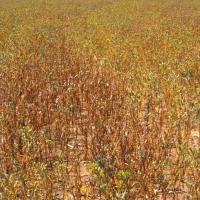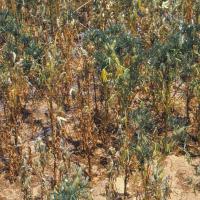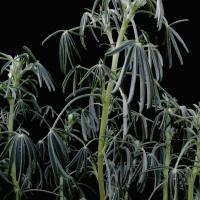Diagnosing spring drought in narrow-leafed lupins
Spring drought refers to plant water stress from insufficient rainfall or stored soil moisture from bud formation to maturity.
What to look for
- Large areas of stressed or dying plants with some better plants in water-gaining areas. Areas most affected include:
- Low water holding soils, such as coarse sands and gravels, very shallow soil over rock or impermeable layer.
- Heavy clays that retain moisture near the soil surface after light rainfall where it is more liable to evaporate.
- Areas within the root zone of trees.
- Double sown areas and more vigourous plants.
Paddock
- During the vegetative stage leaves turn dark green to purple and tend to stand upright. Older leaves turn yellow and die.
- During flowering, flowers are aborted, pod set is significantly reduced and plants are stunted.
- Pod length is reduced and seed development is affected, resulting in shrivelled seed, which may also remain green if the moisture stress is late.
Plant
What else could it be
| Condition | Similarities | Differences |
|---|---|---|
| Diagnosing salinity in narrow-leafed lupins | Reduced yield, early death. | In saline areas. |
| Diagnosing hostile subsoil in narrow-leafed lupins | Reduced yield, early death. | Soil type specific, subsoils may still be moist. |
How can it be monitored?
- Unless the problem is obviously due to drought, dig a hole and examine the soil profile for:
- Soil texture.
- Soil pH.
- Presence of restricting layers.
Page last updated: Thursday, 5 February 2015 - 3:15pm




